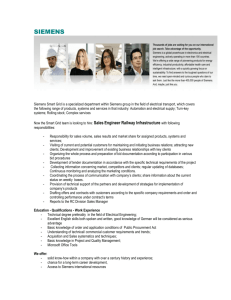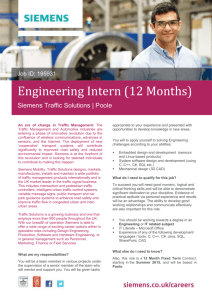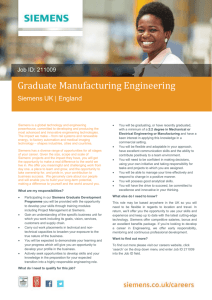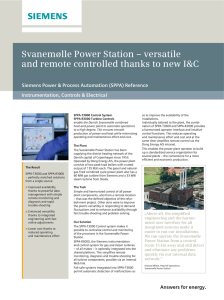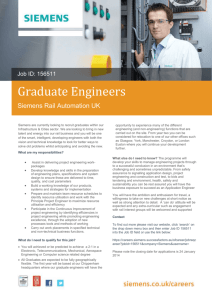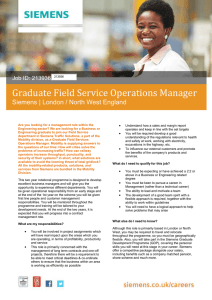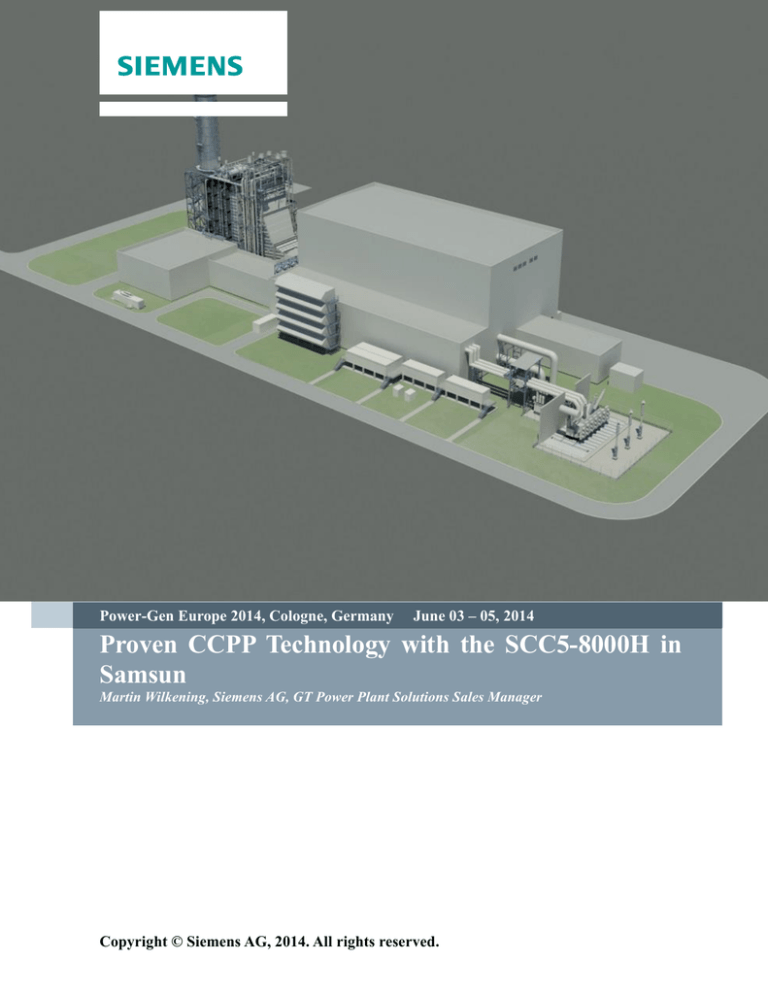
Power-Gen Europe 2014, Cologne, Germany
June 03 – 05, 2014
Proven CCPP Technology with the SCC5-8000H in
Samsun
Martin Wilkening, Siemens AG, GT Power Plant Solutions Sales Manager
Copyright © Siemens AG, 2014. All rights reserved.
Table of content
1. Introduction ...................................................................................................... 3 2. Siemens H-class ................................................................................................ 3 2.1. H-class portfolio and core engine design ............................................................. 3 2.2. SCC-8000H combined cycle power plant solutions ............................................... 5 3. Fleet experience ................................................................................................ 7 3.1. References of the SCC-8000H series ................................................................... 7 3.2. Operational experience ...................................................................................... 9 4. References...................................................................................................... 11 5. Summary........................................................................................................ 12 6. Copyright ....................................................................................................... 13 7. Disclaimer ...................................................................................................... 13 Copyright © Siemens AG 2014. All rights reserved.
P a g e |2
1. Introduction
During the last two decades, the Turkish electricity market has been rapidly growing, with
an average annual growth rate of more than 6%. According to IEA forecasts, it is expected
that electricity consumption will double by 2020. Unless major changes in electricity imports take place, this will require at least doubling the installed generation capacity within a
decade, which constitutes a tremendous challenge. Since the Turkish electricity market faces
strong liberalization and privatization, most of the additions will be provided by independent power producers (IPPs) which face a fully competitive electricity market with all its
uncertainties regarding fuel and electricity prices. The dynamic power plant market in Turkey calls for flexible and eco-friendly power generation facilities that are cost-efficient at
the same time, so that they are right at the top in the merit order. Therefore Siemens is offering its state-of-the-art H-class technology in the Turkish market and placed the first 50 Hz
H-class plant outside Germany first with Cengiz Enerji with a new 580 MW CCPP in Samsun at the Black Sea coast. This success has been followed by the second order of an Hclass plant in Turkey with Enerjisa’s Bandirma II project, which received notice to proceed
in December 2013.
2. Turkish power market characteristics
The Turkish energy sector is characterized by an ongoing process of liberalization and privatization with a strong political target to reduce the account deficit, mainly driven by tremendous imports of oil and gas. On the one hand the privatization process in the energy
sector is in full swing with the distribution networks already sold to private investors, while
the sale of several older power plants – hydro and thermal – is ongoing. Since all new and
privatized power plants are exposed the liberalized merchant market with volatile electricity
prices, operating flexibility is an important feature to be available on demand.
On the other hand Turkey relies heavily on primary energy imports due to limited own resources. Turkey imports more than 40 bcm of natural gas, roughly half of this amount is
used for electricity generation. It is the declared polica of the Turkish government to reduce
this dependency on gas imports which is a key driver for highly efficient power plants.
Based on these characteristics the electricity market demands power plant solutions which
fulfil both requirements at the same time: Operate at highest efficiency and flexibility. The
Siemens H class gas turbine and power plant technology is designed to fulfil these requirements in the best way.
3. Siemens SGT-8000H gas turbine
3.1. H-class portfolio and core engine design
Following the merger of Westinghouse Power Generation with Siemens in 1998, the decision was made to develop a Next Generation Family of Gas Turbines and therewith widen
Copyright © Siemens AG 2014. All rights reserved.
P a g e |3
the existing product portfolio based on the H-class frames for 50Hz and 60Hz markets. The
Siemens gas turbine range spans now from 5 MW for industrial plants to 375 MW for utility
size CCPPs. The SGT-8000H series addresses the major market requirements in terms of
efficiency, environmental protection, operational flexibility and economical value.
The SGT-8000H gas turbine series combines the best design features and technologies of
the established product lines combining high gas turbine efficiency with maximum operating flexibility (Figure 1). The Siemens H-class gas turbine and power plants were designed
from the very beginning with a strong focus on highest level of operational flexibility. The
design challenge was to provide improved plant flexibility without compromising plant service life or plant efficiency. Very early during the Siemens H-class development program a
key design decision was made to select from both inhouse available gas turbine cooling
technologies (air and air/steam) purely internal air-cooling. Due to the heavy impact of the
steam cooling on the engine operational flexibility and design complexity, the internally
fully air-cooled design was selected for the SGT-8000H series. This design feature enables
faster starts, since there is no need to wait for steam from the water/steam cycle. The avoidance of steam cooling and external coolers enables easier simple cycle and bypass operation, faster load following and part load operation. Design simplicity especially in terms of
sealing designs provides higher engine robustness.The SGT-8000H proven design allows
achieving outstanding performance and operational flexibility without the higher risk associated with the steam cooling.
Figure 1: Main efficiency and flexibility related features of SGT-8000H gas turbine series
Copyright © Siemens AG 2014. All rights reserved.
P a g e |4
3.2. SCC-8000H combined cycle power plant solutions
Siemens Energy offers different combined cycle power plant configurations based on single- and multi-shaft arrangements. Additionally Siemens is unique in offering a flexible
scope of supply varying between the power train components via power island scope up to
the entire power plant (turnkey scope). This enables Siemens to support – depending on the
project specific setup – the regional partners and local knowledge. The portfolio flexibility
with regards to different arrangements and scope of supply allows a wide range of technical
and commercial (risk and cost) optimizations (Figure 2).
The power plant SCC-8000H series was developed based on the SGT-8000H as prime mover, the Irsching test plant and the large F-class experience. The design principle comprising
the gas turbine, the generator, the coupling and the steam turbine on a single-shaft remained
the same, as this continues to offer the customer greatest economy and at the same time supreme operational flexibility. The SCC-8000H series is also characterized by its high degree
of harmonization, modularization and compact design towards footprint and space requirements. Recently a multi-shaft arrangement has been developed to provide flexible solutions
e.g. for small power plant sites. Both solutions for 50Hz and 60Hz markets are based on the
same design principles.
Figure 2: H-class power plant solutions enable different arrangements
Copyright © Siemens AG 2014. All rights reserved.
P a g e |5
The implementation of the FACYTM concept in combination with the hot start on-the-fly
allows a hot start-up time reduction down to less than 30 minutes in comparison to “conventional” hot starts. The concept is based on a procedure for parallel start-up of gas and steam
turbines, while monitoring and controlling the temperature gra-dients within limits acceptable for all critical plant components. Further, the design is based on a long term operation
experience with different steam conditions in the Siemens turbine design. A new start-up
sequence, which avoids gas turbine load hold points, was implemented. The main innovation here is the early steam turbine starting point with earlier acceleration and loading of the
turbine. The FACYTM technology allows for higher number of starts and faster cycling
without compromising plant lifetime consumption.
Figure 3: SCC-8000H series combines advanced water-steam cycle design with FACYTM technology for
a perfect match between highest efficiency and plant operational flexibility
As H-class gas turbines provide high exhaust temperatures >620 °C, a further efficiency
increase was achieved based on an advanced triple pressure reheat water steam cycle (up to
600°C inlet temperature and 170 bar inlet pressure). Despite high live steam parameters, the
plant flexibility is further improved by use of a BENSON® type HRSG and condensate polishing (Figure 23). Compared to other combined cycle power plants using gas turbine steam
Copyright © Siemens AG 2014. All rights reserved.
P a g e |6
cooling, the number of main and auxiliary systems and their complexity are kept extremely
low and therefore even the plant footprint could be reduced to the minimum.
The project specific selection of major design parameters and components is always a result
of an overall life cycle cost optimization, which comprises invest, efficiency and operational
flexibility aspects allowing maximization of customer’s value add and investment security.
Siemens is offering a wide and flexible H-class combined cycle power plant portfolio based
on long lasting experience and pre-designed and pre-optimized solutions, which provide an
answer to the leading market requirements.
4. Fleet experience
4.1. References of the SCC-8000H series
With the successful conclusion of “Ulrich Hartmann” plant in Irsching (unit #4) and the
related validation and testing phases, Siemens Energy is the first OEM to handover a gas
turbine engine and a combined cycle plant with efficiency far beyond 60%. Siemens impressively demonstrated that world-record technology is now world wide commercially
available to customers.
The next commercial success was achieved in Florida, USA, where 9 units of the SGT68000H were placed. All Florida Power & Light sites in Cape Canaveral (all three engines
are already in commercial operation), Riviera Beach, and Port Everglades are equipped with
the SGT6-8000H gas turbines in a multi-shaft configuration (3 on 1) and provide approximately 1200 MW electrical energy each (Figure 5). Prior to shipment to first customer’s site
(Cape Caneveral) the full scale 60Hz engine was thoroughly tested in the Berlin test facility.
At the same time period the next order from South Korea for the supply of a complete combined cycle power plant equipped with the SGT6-8000H in a single shaft configuration was
placed by the independent power producer GS Electric Power & Services, Ltd. As a consortium leader, Siemens installed the 400MW class power plant Dangjin 3 as a turnkey project.
In 2012 and 2013 further seven units were successfully sold in South Korea, with Ansan as
a multi-shaft configuration, Andong, Posco Power 2 as a single shaft arrangement and Daegu City as a single shaft with a CHP application.
Following the success in Asia Siemens Energy has received an order for turnkey erection of
the Lausward combined cycle power plant with district heat extraction in Düsseldorf, Germany. Further contract awards were recently achieved in the US in Pennsylvania with Moxie Liberty as a double unit single shaft SCC6-8000H 1S, in Turkey a 50Hz single shaft unit
and in Malaysia also with a double single shaft unit in Prai. Currently several projects are in
final negoceation steps, confirming the world wide acceptance of the SCC-8000H power
plants and customer’s trust in this proven technology.
End of 2012 Siemens received the notice to proceed for the Cengiz Samsun 600 MW CCPP
which reflects another important milestone for the success of the Siemens H-class technology. With the SCC5-8000H CCPP and its core component SGT5-8000H, Cengiz Enerji will
feature the most efficient fossil fired power plant in Turkey with a net efficiency of almost
Copyright © Siemens AG 2014. All rights reserved.
P a g e |7
61%. The power plant is configured as a single-shaft configuration and will meet all requirements for a flexible power plant with short startup times and fast load capability and
will be the stabile complement for the Turkish grid supply. This plant is capable of producing full load in as little as 30 minutes after eight hours shutdown. Furthermore, it reacts very
quickly to grid fluctuations and can adapt its output by more than 35 MW within one minute
to meet the changing power requirements. The power plant is currently under construction;
all major equipment has been shipped to site, the power train has been installed in the turbine building and the HRSG is almost fully assembled. Cold commissioning has started
already, first fire is scheduled for 31. August 2014.
Figure 4: Samsun 600 MW CCPP – Turbine hall view from January 2014
In December 2013 Siemens has received the order for the turnkey construction of the
Bandirma II CCPP in Turkey. The purchaser is Enerjisa, a joint venture of Sabanci Holding
and E.ON. Following the Samsun project, which is currently under construction, Bandirma
II will be the second power plant in Turkey to be powered by an SGT5-8000H gas turbine,
marking the sale of 28 of this model of gas turbine by Siemens worldwide. These gas turbines, which have proven themselves in commercial operation since 2011, have now
clocked up more than 70,000 equivalent operating hours at an availability of more than 97
percent. Upon completion in the spring of 2016, this plant will have an installed capacity of
close to 600 MW and an efficiency of over 60 percent.
Copyright © Siemens AG 2014. All rights reserved.
P a g e |8
Figure 5: H-class world wide references
4.2. Operational experience
Since “Ulrich Hartmann” handover in July 2011, SCC5-8000H has achieved in the Irsching
4 power plant in sum more than 16,000 equivalent operating hours and more than 450 starts.
Depending on the grid dispatch requirements the unit is running in a daily start / stop and
load following mode according to the dispatch requirements.
Several planned short time outages were performed and allowed a visual inspection of the
hot gas path and confirmed the anticipated excellent engine conditions. The combustor inspection took place at 12,000 equivalent operating hours (EOH) outage in May 2012. The
engine conditions and the hot gas path components were found to be in excellent condition.
Further opportunistic inspections were done, the latest in August 2013. The results are more
than satisfying, as the engine and the overall plant components are in an excellent shape,
confirming accordingly the expected lifetime prediction (Figure 6). The intensive monitoring of “Ulrich Hartmann” shows also outstanding plant availability and starting reliability,
which is necessary for a daily cycling operating regime.
Copyright © Siemens AG 2014. All rights reserved.
P a g e |9
In 2013 the first four 60Hz H-class power plants achieved commercial operation successfully and ahead of schedule. The units are running at base load and provide the fleet with very
positive feedback in terms of performance and of course reliability and availability. The
overall SCC-8000H fleet has today exceeded 70.000 EOH and in 2015 the 250.000 EOH
mark will be surpassed.
Figure 6: Ulrich Hartmann (Irsching unit #4) inspection summary
Copyright © Siemens AG 2014. All rights reserved.
P a g e | 10
5. References
[1]
W. Fischer, S. Abens, “SGT5-8000H Design and Product Validation at Irsching 4 Test
Center”, VGP Power Tec 09/2009
[2]
W. Fischer, “SGT5-8000H / IRSCHING 4: On The Way To 60% World Record Efficiency And Path To 60 Hz SGT6-8000H”, 18th Conference of the Electric Power Supply Industry (CEPSI), Taipei, Taiwan, Oct. 2010
[3]
L. Balling, Dr. U. Tomschi, A. Pickard, G. Meinecke, “Fast Cycling and Grid Support
Capability of Combined Cycle Power Plants to optimize the Integration of Renewable
Generation into the European Grid: Live examples from projects in NL, F, UK, D”,
PowerGen Europe, Amsterdam, June. 2010
[4]
Dr. K. Sfar, T. Hagedorn, “Siemens H-Class CCPP Technology: Implementation of the
first 50Hz unit and update on latest 60Hz plant design standard”, PowerGen Asia, Kuala
Lumpur, Sept. 2011
[5]
A. Kessler, T. Hagedorn, “Bugok 3: Bringing the H-Class Gas Turbine to Korea”, Modern Power Systems, Sept. 2011
[6]
W. Fischer, A. Städtler, “SGT5/6-8000H & SCC5/6-8000H Product Line: Advanced
Generation of High Performance Gas Turbine and Combined Cycle System”, 6th IDGTE GT Conference, Milton Keynes, November 2011
[7]
A. Städtler, “SGT5-8000H/SCC5-8000H 1S First experience of Commercial Operation
at Irsching 4”, Russia Power, Moscow, March 2012
[8]
P. Bullinger, “Enhanced water/steam-cycle for advanced combined cycle technology”,
Power-Gen Asia, Bangkok, October 2012
[9]
Dr. K. Sfar, A. Staedtler, “Update on Siemens 8000H CCPP Technology and Operational
experience ”, Power-Gen Asia, Bangkok, October 2012
[10] M. Wilkening, “Efficiency and Flexibility in Gas to Power Generation - Roles of CCPPs
in the energy market”, Gas to Power Turkey Forum, Ankara, November 2013
Copyright © Siemens AG 2014. All rights reserved.
P a g e | 11
6. Summary
The Turkish electricity market faces two main challenges: On the one hand the majority of
electricity generation is still based on gas fired power plants which rely on expensive imports from several countries around Turkey. On the other hand the privatization and liberalization is progressing fast, reflected in volatile electricity prices exposing the several generating companies to a challenging market environment. To cope with these challenges the
new CCPPs have to be highly efficient and flexible at the same time – requirements which
can be fulfilled by the Siemens SCC5-8000H power plants in an excellent way.
This paper provides an overview of the Siemens SCC-8000H gas turbine, which is meanwhile recognized as fully proven technology. The main design features displaying the outstanding efficiency and operating flexibility of the SGT-8000H gas turbine series are presented. Siemens’ H-Class product portfolio is based on single shaft and multi shaft arrangements with optimized water / steam cycle and live steam parameters up to 600°C and
170 bars. The wide range of different solutions is based on pre-engineered and preoptimized designs. The product portfolio offers several solutions with a flexible scope of
supply and covers all relevant applications for 50Hz and 60Hz, e.g. Cogeneration.
In order to achieve highest operational efficiency without compromising the plant efficiency
and its service life, Siemens Energy Solutions based all development activities on a global
integrated approach, where all plant components besides the gas turbine are considered and
optimized at the same time. This is possible, since Siemens Energy Solutions has all required engineering competencies and major components inhouse. The global solution design
approach enables the achievement of outstanding performance, flexibility and reliability
results as it has been impressively demonstrated in Ulrich Hartman plant, our H-class front
runner. Finally Siemens Energy Solutions global approach leads to economically viable and
sustainable answers, which drastically reduce life cycle cost and hence maximize customer’s value add.
The commercial success of the SCC-8000H series provides numerous proof points of Siemens Energy Solutions’ philosophy. The worldwide acceptance of this product line from
Asia over Europe to the United States shows our cutomer’s trust. Latest project awards provide references for all different plant configurations from 1 on 1 up to 3 on 1 arrangement,
from a daily cycling plant up to purely baseload plant, from 100% condensation operation
up to large steam extraction.
This paper emphasizes the lighthouse projects Cengiz Samsun 600 MW CCPP and Enerjisa’s Bandirma II CCPP which will be the benchmarking CCPPs in Turkey in terms of efficiency and operating flexibility in the near future.
Copyright © Siemens AG 2014. All rights reserved.
P a g e | 12
7. Copyright
The content of this paper is copyrighted by Siemens AG Energy Sector and is licensed only to
Sektörel Fuarcılık A.Ş. for publication and distribution. Any inquiries regarding permission to use
the content of this paper, in whole or in part, for any purpose must be addressed to Siemens AG
Energy Sector directly.
8. Disclaimer
This document contains forward-looking statements and information – that is, statements related to
future, not past, events. These statements may be identified either orally or in writing by words as
“expects”, “anticipates”, “intends”, “plans”, “believes”, “seeks”, “estimates”, “will” or words of
similar meaning. Such statements are based on our current expectations and certain assumptions,
and are, therefore, subject to certain risks and uncertainties. A variety of factors, many of which are
beyond Siemens’ control, affect its operations, performance, business strategy and results and could
cause the actual results, performance or achievements of Siemens worldwide to be materially different from any future results, performance or achievements that may be expressed or implied by such
forward-looking statements. For us, particular uncertainties arise, among others, from changes in
general economic and business conditions, changes in currency exchange rates and interest rates,
introduction of competing products or technologies by other companies, lack of acceptance of new
products or services by customers targeted by Siemens worldwide, changes in business strategy and
various other factors. More detailed information about certain of these factors is contained in Siemens’ filings with the SEC, which are available on the Siemens website, www.siemens.com and on
the SEC’s website, www.sec.gov. Should one or more of these risks or uncertainties materialize, or
should underlying assumptions prove incorrect, actual results may vary materially from those described in the relevant forward-looking statement as anticipated, believed, estimated, expected, intended, planned or projected. Siemens does not intend or assume any obligation to update or revise
these forward-looking statements in light of developments which differ from those anticipated.
Trademarks mentioned in this document are the property of Siemens AG, its affiliates or their respective owners.
Copyright © Siemens AG 2014. All rights reserved.
P a g e | 13

